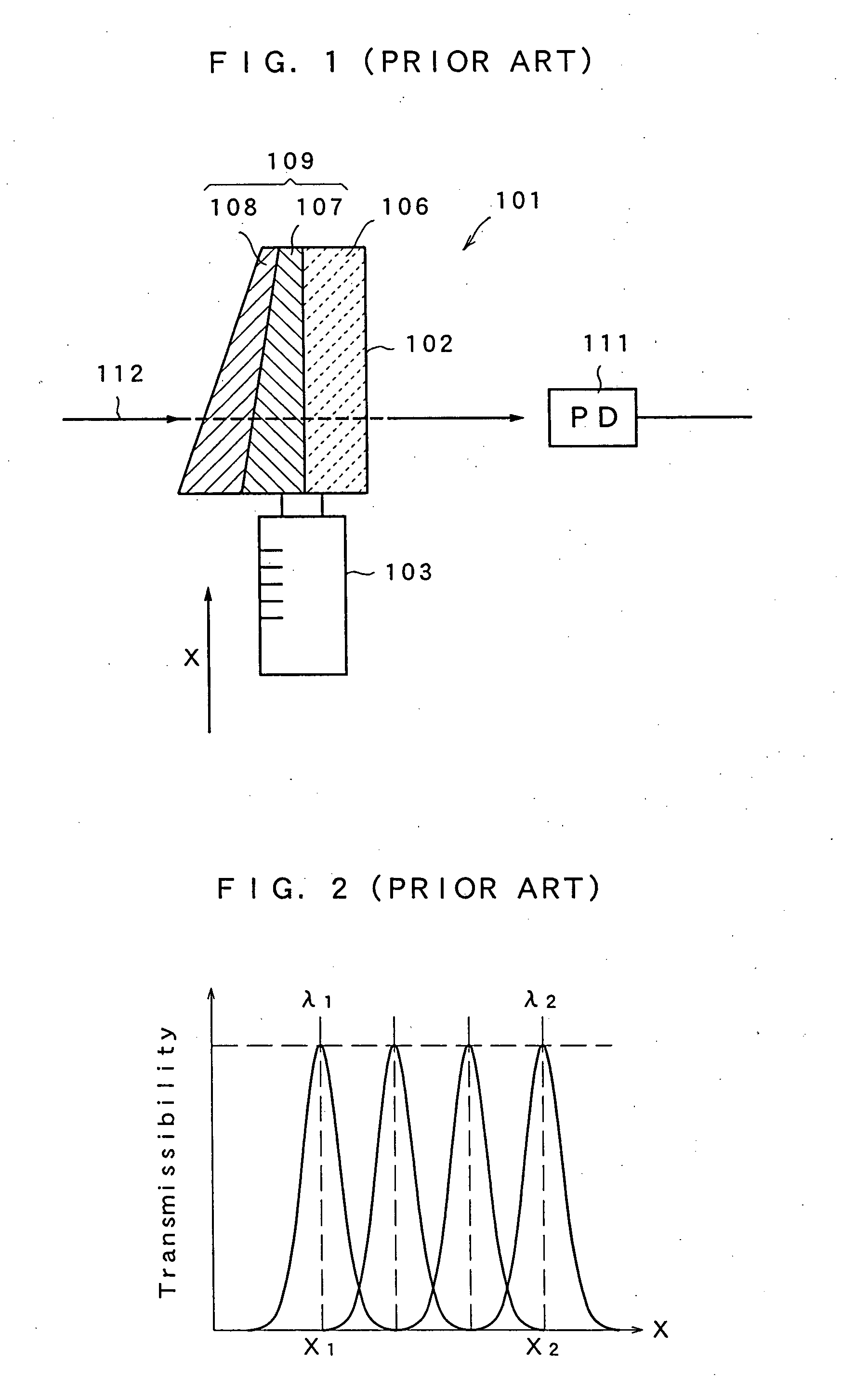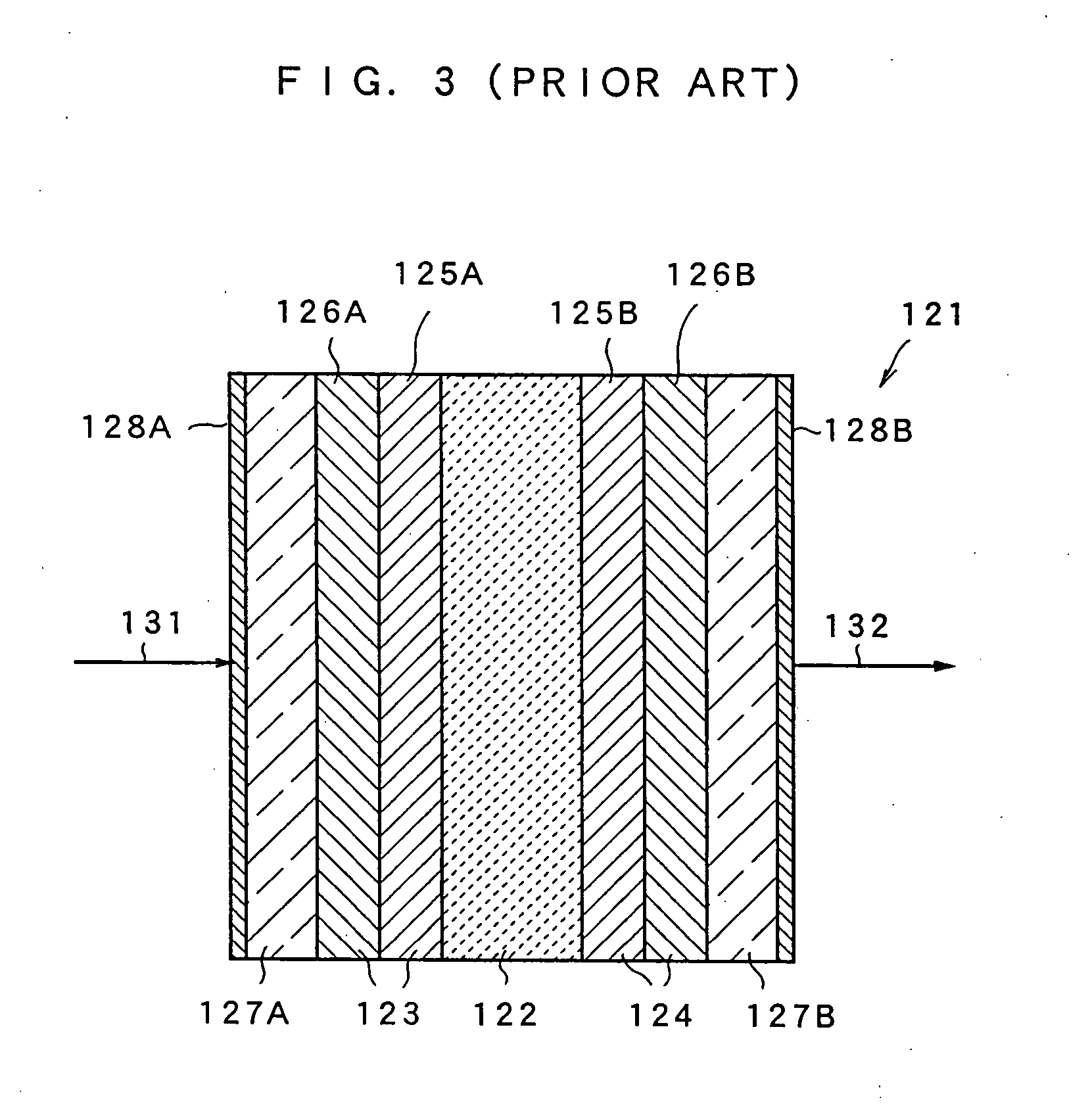Optical element and optical add-drop module
a technology of optical elements and modules, applied in the field of optical elements and optical adddrop modules, can solve the problems of high cost, difficult control of the thickness of the film layer which constitutes the multi-layer film filter, and high production costs, and achieves excellent environmental resistance, low cost, and improved reliability.
- Summary
- Abstract
- Description
- Claims
- Application Information
AI Technical Summary
Benefits of technology
Problems solved by technology
Method used
Image
Examples
first embodiment
[0070] (First Embodiment)
[0071] Next, the following description will discuss a first embodiment of the present invention. FIG. 4 shows the outline of the structure of an optical element 201 in accordance with of the first embodiment of the present invention. This optical element 201 has a structure in that a first mirror stack layer 203 is formed on a substrate 202 with a first conductive thin film 204 being formed thereon. The layer 203 and film 204 constitute a first composite stack layer. Then, a spacer layer 205, which is a paraelectric layer that exerts a secondary electrooptic effect, is formed thereon. Moreover, a second composite stack layer, constituted by a second conductive thin film 206 and a second mirror stack layer 207, is formed thereon. A coupling layer 208 is further formed thereon to form a basic structure. The coupling layer 208 (low-refractive index dielectric thin film L forming the uppermost layer), located on the second mirror stack layer 207, is made in cont...
second embodiment
[0105] (Second Embodiment)
[0106] The following description will discuss the embodiments of the present invention by exemplifying cases in which the optical element is practically applied to a bandpass filter.
[0107]FIG. 5 shows the structure of a tunable etalon in accordance with a second embodiment of the present invention theoretically. Here, the etalon is an optical element in which an illuminator is formed on the inside of an optical flat. A tunable etalon 301 of the present embodiment may be used as, for example, a tunable optical filter, and has its design wavelength λ0 of 1550 nm.
[0108] The tunable etalon 301 has a structure in that each of first and second composite stack layers 302 and 303 is joined to each of two surfaces of a spacer layer 304. Here, the first composite stack layer 302 has a structure in that: a first mirror stack layer 3121 is laminated on a BK7 glass substrate 3111 made of borosilicate glass; a transparent conductive film 3131 is vapor deposited on the ...
third embodiment
[0121] (Third Embodiment)
[0122]FIG. 8 shows the cross-sectional structure of a single cavity-type tunable bandpass filter with no electrode attached thereto, in accordance with the third embodiment of the present invention. A single cavity-type tunable bandpass filter 401 has a structure in that a first mirror stack layer 4111 is formed on aBK7 glass substrate 402. With respect to the first mirror stack layer 4111, a Ta2O5 film is used as a dielectric thin film 403, that is, the high-refractive index dielectric thin film H, and an SiO2 film is used as the low-refractive index dielectric thin film L, and seven sets of these films are laminated (in the figure, only two sets are briefly shown). An ITO film (refractive index: nc=2.0) is formed as a transparent conductive film 4121 on the stack layer 4111. The transparent conductive film 4121 serves as a transparent film in the vicinity of a wavelength of 500 nm, and has resistivity of 4×10−4 Ωcm.
[0123] A spacer layer 413 is formed on t...
PUM
| Property | Measurement | Unit |
|---|---|---|
| thickness | aaaaa | aaaaa |
| thickness | aaaaa | aaaaa |
| thickness | aaaaa | aaaaa |
Abstract
Description
Claims
Application Information
 Login to View More
Login to View More - R&D
- Intellectual Property
- Life Sciences
- Materials
- Tech Scout
- Unparalleled Data Quality
- Higher Quality Content
- 60% Fewer Hallucinations
Browse by: Latest US Patents, China's latest patents, Technical Efficacy Thesaurus, Application Domain, Technology Topic, Popular Technical Reports.
© 2025 PatSnap. All rights reserved.Legal|Privacy policy|Modern Slavery Act Transparency Statement|Sitemap|About US| Contact US: help@patsnap.com



